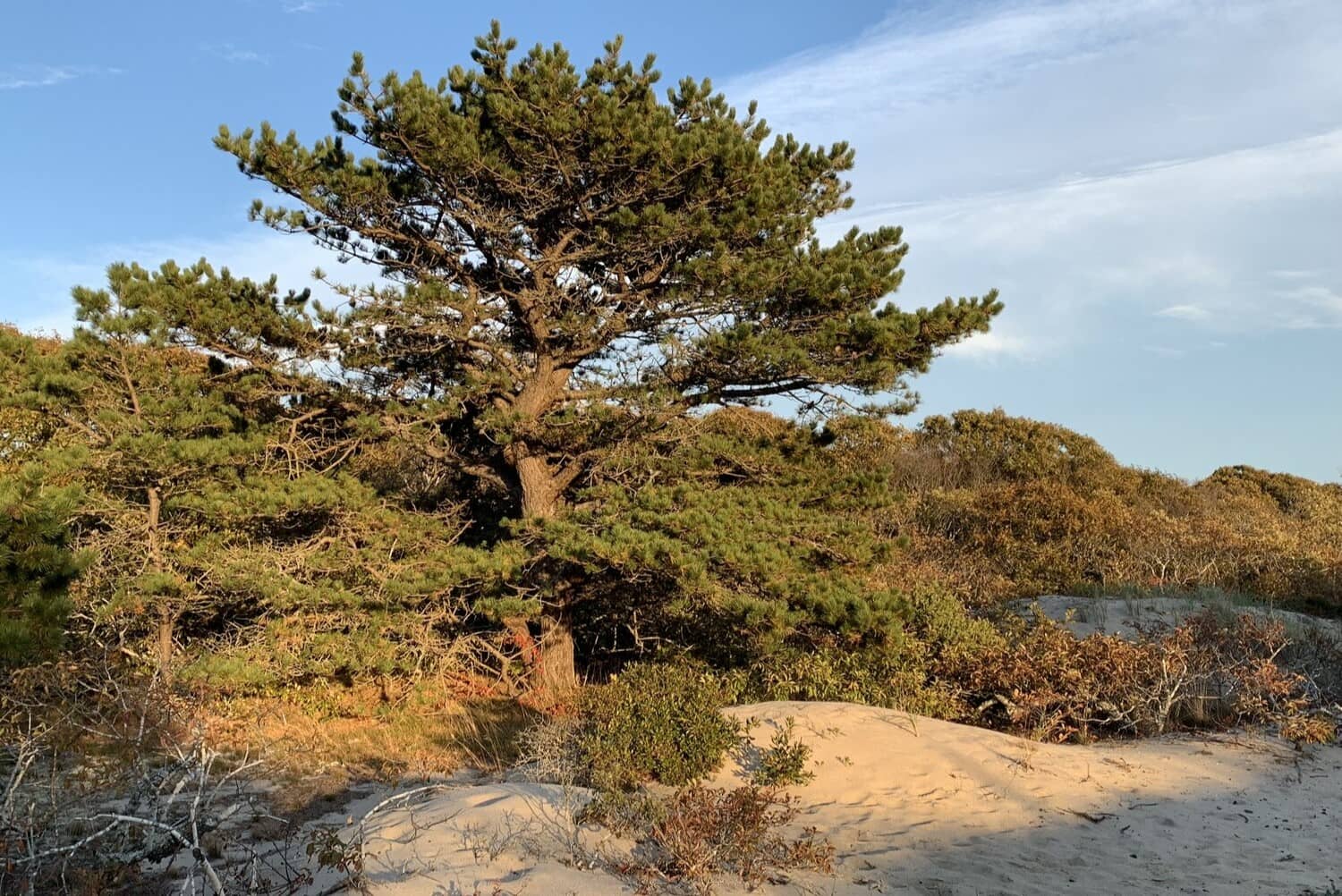
Pitch pine trees are fascinating and resilient members of the pine family, known for their rugged beauty and remarkable adaptability. These remarkable trees are native to eastern North America, thriving in diverse habitats ranging from sandy coastal plains to rocky upland areas. Their distinctive, twisted branches and dark green needles make them a striking presence in the landscape. Despite facing challenges such as wildfires and harsh environmental conditions, pitch pine trees have evolved unique survival mechanisms, including serotinous cones that release seeds in response to intense heat, ensuring the species' regeneration. In addition to their ecological significance, these trees have played a vital role in supporting various wildlife species and contributing to the overall biodiversity of their habitats. Join us as we delve into 18 intriguing facts about pitch pine trees, unveiling their extraordinary features and the indispensable role they play in the natural world.
Key Takeaways:
- Pitch pine trees are tough and adaptable, thriving in tough environments and playing a crucial role in supporting diverse wildlife. Their unique appearance and historical significance make them a cherished part of nature.
- These resilient trees have a rich history, from being used in shipbuilding to providing medicinal resin. They symbolize strength and endurance, and conservation efforts are focused on preserving their habitats for the future.
18 Pitch Pine Tree Facts
Pitch pine trees, scientifically known as Pinus rigida, are fascinating and resilient evergreen trees that are native to eastern North America. Here are 18 intriguing facts about these remarkable trees:
Pitch Pine Trees Thrive in Challenging Environments
Pitch pine trees are well-adapted to harsh conditions, often growing in poor, sandy soils and tolerating drought and fire. Their ability to thrive in challenging environments makes them a vital component of many ecosystems.
The Unique Appearance of Pitch Pine Trees
These trees are easily recognizable by their rugged, twisted trunks and irregular crowns. The branches often grow in a chaotic manner, giving the tree a distinctive and picturesque appearance.
Pitch Pine Trees Have a Long Lifespan
Pitch pine trees are known for their longevity, with some individuals living for several centuries. Their resilience and ability to withstand adverse conditions contribute to their impressive lifespan.
The Resinous Nature of Pitch Pine Trees
As the name suggests, pitch pine trees are characterized by their high resin content. The resin not only provides protection against pests and diseases but also makes the wood highly resistant to decay.
Pitch Pine Trees Play a Crucial Role in Fire Ecology
These trees have evolved to survive and even benefit from wildfires. Their thick bark and fire-resistant needles enable them to endure intense heat, and their cones open and release seeds in response to the heat of a fire, allowing for rapid regeneration of the forest after a blaze.
Pitch Pine Trees Provide Habitat for Wildlife
The dense, twisted branches of pitch pine trees create an ideal habitat for various wildlife species. Birds, small mammals, and insects find shelter and nesting sites within the tree's unique structure.
Pitch Pine Trees Are Valued for Timber
Despite their knotty and irregular growth, pitch pine trees are harvested for timber, particularly for use in construction and woodworking. The wood's durability and resistance to decay make it desirable for various applications.
The Historical Significance of Pitch Pine Trees
Pitch pine played a significant role in American history, as it was used for shipbuilding during the colonial era. The resin from these trees was also utilized in the production of pitch, tar, and turpentine.
Pitch Pine Trees Are a Source of Pitch
The high resin content of pitch pine trees has been historically exploited for the extraction of pitch, a viscous substance used in various industrial and commercial applications, including waterproofing and sealing.
The Ecological Importance of Pitch Pine Forests
Pitch pine forests support a diverse array of plant and animal species and contribute to the overall health of the ecosystem. Their presence helps maintain biodiversity and provides valuable ecological services.
Pitch Pine Trees Are Found in Protected Areas
These resilient trees are often found in protected natural areas, where they contribute to the preservation of unique habitats and the conservation of biodiversity.
Pitch Pine Trees Are Used in Landscaping
Due to their rugged beauty and ability to thrive in challenging conditions, pitch pine trees are commonly used in landscaping and reforestation efforts, particularly in areas with poor soil quality.
Pitch Pine Trees Have Medicinal Uses
The resin obtained from pitch pine trees has been traditionally used for its medicinal properties, with applications ranging from wound healing to respiratory treatments.
Pitch Pine Trees Are Symbolic in Native American Culture
In some Native American traditions, pitch pine trees hold cultural significance and are associated with resilience, strength, and the enduring spirit of nature.
Pitch Pine Trees Are Resilient Urban Trees
These adaptable trees are also utilized in urban environments, where they can withstand pollution, compacted soil, and other stressors commonly found in city landscapes.
Pitch Pine Trees Are a Symbol of Resilience
The remarkable ability of pitch pine trees to thrive in adverse conditions has made them a symbol of resilience and endurance, inspiring admiration and respect.
Pitch Pine Trees Are a Focal Point for Conservation Efforts
Due to their ecological importance and unique characteristics, pitch pine trees are the focus of conservation initiatives aimed at preserving their habitats and ensuring their continued existence for future generations.
Pitch pine trees are truly remarkable, embodying resilience, ecological significance, and a rich historical legacy. Their unique adaptations and contributions to the environment make them a valuable and cherished component of the natural world.
Conclusion
In conclusion, the pitch pine tree is a remarkable species that plays a crucial role in various ecosystems. Its unique adaptations, such as fire resistance and ability to thrive in harsh conditions, make it a resilient and valuable component of forests. The pitch pine's historical significance, ecological importance, and diverse uses highlight its relevance in both natural and human environments. By understanding these 18 fascinating facts about pitch pine trees, we gain a deeper appreciation for their significance and the need to conserve and protect these remarkable trees for future generations.
FAQs
What are the main characteristics of pitch pine trees?
Pitch pine trees are characterized by their stout, twisted trunks, dark green needles in bundles of three, and distinctive, resinous sap with a strong odor. These trees are well-adapted to survive in fire-prone environments, thanks to their thick bark and serotinous cones.
How can pitch pine trees be used by humans?
Pitch pine trees have been historically utilized for various purposes, including timber for construction, resin extraction for naval stores, and as an ornamental tree in landscaping. Additionally, the pitch pine's dense wood is valued for its durability and is used in crafting furniture, flooring, and other wooden products.
Was this page helpful?
Our commitment to delivering trustworthy and engaging content is at the heart of what we do. Each fact on our site is contributed by real users like you, bringing a wealth of diverse insights and information. To ensure the highest standards of accuracy and reliability, our dedicated editors meticulously review each submission. This process guarantees that the facts we share are not only fascinating but also credible. Trust in our commitment to quality and authenticity as you explore and learn with us.


